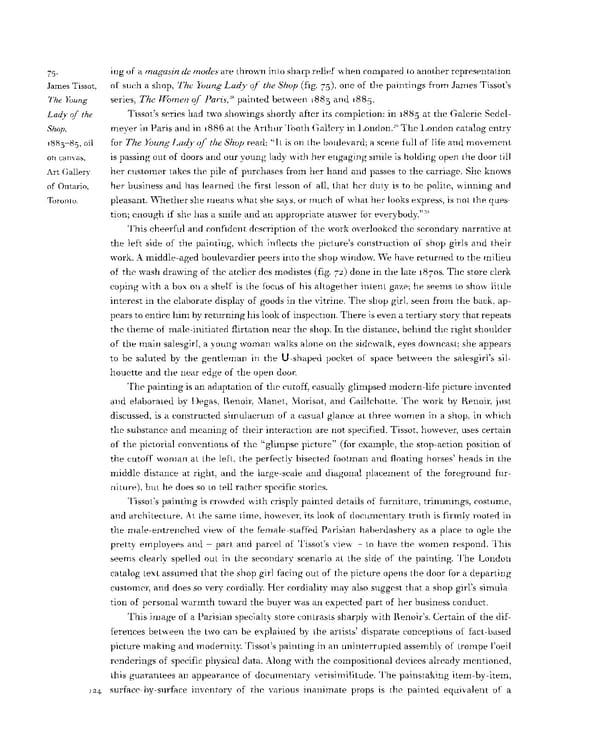75- ing of a magasin de modes are thrown into sharp relief when compared to another representation James Tissot, of such a shop, The Young Lady of the Shop (fig. 75), one of the paintings from James Tissot's The Young series, The Women of Paris,28 painted between 1883 and 1885. Lady of the Tissot's series had two showings shortly after its completion: in 1885 at the Galerie Sedel- 29 Shop, meyer in Paris and in 1886 at the Arthur Tooth Gallery in London. The London catalog entry 1883-85, oil for The Young Lady of the Shop read: "It is on the boulevard; a scene full of life and movement on canvas, is passing out of doors and our young lady with her engaging smile is holding open the door till Art Gallery her customer takes the pile of purchases from her hand and passes to the carriage. She knows of Ontario, her business and has learned the first lesson of all, that her duty is to be polite, winning and Toronto. pleasant. Whether she means what she says, or much of what her looks express, is not the ques- tion; enough if she has a smile and an appropriate answer for everybody."30 This cheerful and confident description of the work overlooked the secondary narrative at the left side of the painting, which inflects the picture's construction of shop girls and their work. A middle-aged boulevardier peers into the shop window. We have returned to the milieu of the wash drawing of the atelier des modistes (fig. 72) done in the late 18705. The store clerk coping with a box on a shelf is the focus of his altogether intent gaze; he seems to show little interest in the elaborate display of goods in the vitrine. The shop girl, seen from the back, ap- pears to entice him by returning his look of inspection. There is even a tertiary story that repeats the theme of male-initiated flirtation near the shop. In the distance, behind the right shoulder of the main salesgirl, a young woman walks alone on the sidewalk, eyes downcast; she appears to be saluted by the gentleman in the U-shaped pocket of space between the salesgirl's sil- houette and the near edge of the open door. The painting is an adaptation of the cutoff, casually glimpsed modern-life picture invented and elaborated by Degas, Renoir, Manet, Morisot, and Caillebotte. The work by Renoir, just discussed, is a constructed simulacrum of a casual glance at three women in a shop, in which the substance and meaning of their interaction are not specified. Tissot, however, uses certain of the pictorial conventions of the "glimpse picture" (for example, the stop-action position of the cutoff woman at the left, the perfectly bisected footman and floating horses' heads in the middle distance at right, and the large-scale and diagonal placement of the foreground fur- niture), but he does so to tell rather specific stories. Tissot's painting is crowded with crisply painted details of furniture, trimmings, costume, and architecture. At the same time, however, its look of documentary truth is firmly rooted in the male-entrenched view of the female-staffed Parisian haberdashery as a place to ogle the pretty employees and — part and parcel of Tissot's view — to have the women respond. This seems clearly spelled out in the secondary scenario at the side of the painting. The London catalog text assumed that the shop girl facing out of the picture opens the door for a departing customer, and does so very cordially. Her cordiality may also suggest that a shop girl's simula- tion of personal warmth toward the buyer was an expected part of her business conduct. This image of a Parisian specialty store contrasts sharply with Renoir's. Certain of the dif- ferences between the two can be explained by the artists' disparate conceptions of fact-based picture making and modernity. Tissot's painting in an uninterrupted assembly of trompe 1'oeil renderings of specific physical data. Along with the compositional devices already mentioned, this guarantees an appearance of documentary verisimilitude. The painstaking item-by-item, 124 surf ace-by-surface inventory of the various inanimate props is the painted equivalent of a
 Prostitution & Impressionists Page 144 Page 146
Prostitution & Impressionists Page 144 Page 146